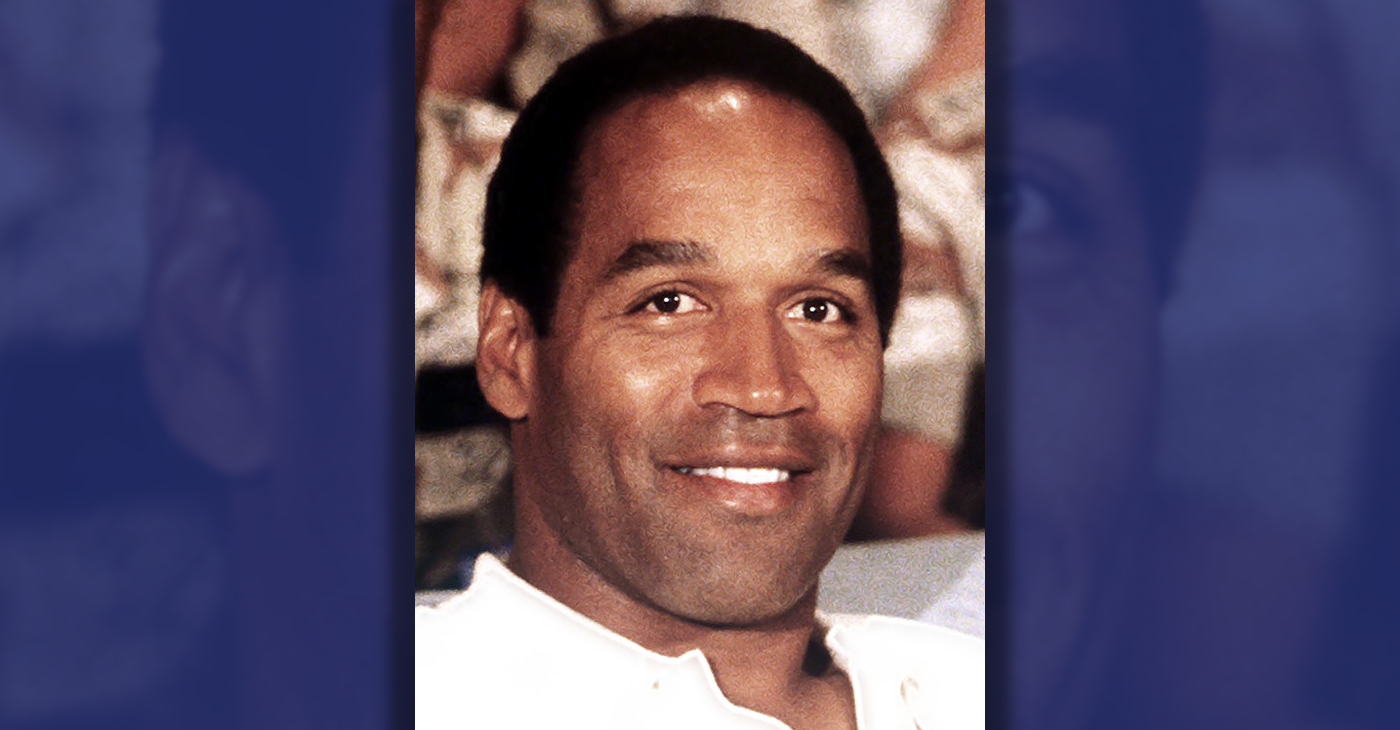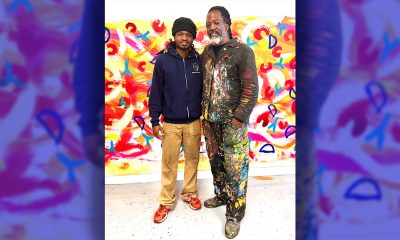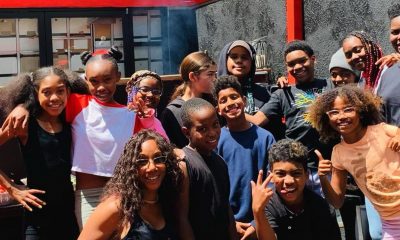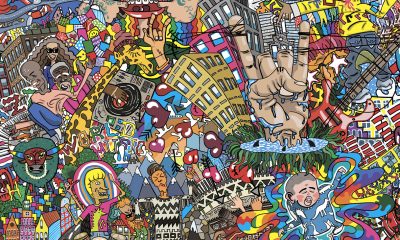Entertainment
Jacob Lawrence’s Migration Series on View at MoMA

This photo provided by the Museum of Modern Art courtesy of The Phillips Collection, Washington D.C., shows a panel of The Great Migration series by African-American artist Jacob Lawrence titled “During the World War there was a great migration North by Southern Negroes.” (Museum of Modern Art courtesy The Phillips Collection, Washington D.C. via AP)
ULA ILNYTZKY, Associated Press
NEW YORK (AP) — One hundred years ago, African-Americans began a mass exodus from the rural South, heading north in search of economic opportunity and social equality. The Museum of Modern Art is paying tribute to that movement in a rare exhibition of a series chronicling the phenomenon from artist Jacob Lawrence, himself the son of migrants.
His Migration Series, featuring 60 poignant narrative paintings, is the centerpiece of the exhibition that runs through Sept. 7.
Lawrence, who died in 2000, was only 23 when he completed the works in 1941. The small tempera paintings depict various scenes of the multi-decade mass movement that began in 1915. Executed in bold colors, they portray scenes of life and death, work, home and hardships for the millions of African-Americans who relocated North in pursuit of a better future.
The year they were finished, the paintings were exhibited at the Downtown Gallery in Manhattan, marking the first time a black artist was represented by a New York gallery. Soon after, they entered the collections of MoMA and The Phillips Collection in Washington, D.C., with each acquiring half.
The exhibition, “One-Way Ticket: Jacob Lawrence’s Migration Series and Other Visions of the Great Movement North,” is the first time the entire series is on view at MoMA in 20 years. Phillips showed all 60 panels in 2008.
To put the paintings in historical context, the exhibition also includes video and audio recordings of performances by Duke Ellington and Billie Holiday; photographs by Dorothea Lange and Gordon Parks; and writings by Langston Hughes and Richard Wright. A special interactive website allows people to explore zoomable high-resolution images of all 60 panels.
In conjunction with the exhibition, the museum will hold a panel discussion next week led by Khalil Gibran Muhammad, director of the Schomburg Center for Research in Black Culture, on the continuing legacy of Jim Crow — how it shapes issues of race, justice and public policy today. It also has commissioned 10 noted poets to create poetry based on Lawrence’s series.
“The migration series is not history set in the past, but rather an ongoing phenomenon,” said exhibition curator Leah Dickerman. “It’s contemporary history focused on the experience of ordinary people and he tells it in a contemporary, almost cinematic way.”
The series opens with an image of a chaotic crowd in a train station pushing toward three ticket windows marked Chicago, New York and St. Louis.
Lawrence was the son of migrants who moved to Harlem when he was 13. “He often spoke of hearing stories of people ‘coming up’ from friends and family,” said Dickerman. Lawrence spent months on research before embarking on the series, beginning by coming up with short captions for the scenes he planned.
In an image of a large group of migrants weighed down with heavy bags he simply states: “The migration gained momentum.” Another of a migrant worker with his tenant landlord says “tenant farmers received harsh treatment at the hands of planters.”
Among other reasons blacks left in droves were lynchings in the South and the freedom to vote in the North, Lawrence said in captions accompanying other pictures.
So many left, that “crops were left to dry and spoil … there was no one to tend to them,” he says for a painting of a withering field.
___
If You Go…
MIGRATION SERIES: Exhibition of paintings by Jacob Lawrence through Sept. 7 at Museum of Modern Art, 11 W. 53rd St., Manhattan. Open daily, 10:30 a.m.-5:30 p.m. and until 8 p.m. on Fridays. Adults, $25.
Copyright 2015 The Associated Press. All rights reserved. This material may not be published, broadcast, rewritten or redistributed.
Activism
Oakland Post: Week of April 24 – 30, 2024
The printed Weekly Edition of the Oakland Post: Week of April 24 – 30, 2024

To enlarge your view of this issue, use the slider, magnifying glass icon or full page icon in the lower right corner of the browser window. ![]()
Activism
Oakland Post: Week of April 17 – 23, 2024
The printed Weekly Edition of the Oakland Post: Week of April 17 – 23, 2024

To enlarge your view of this issue, use the slider, magnifying glass icon or full page icon in the lower right corner of the browser window. ![]()
Entertainment
O.J. Simpson, 76, Dies of Prostate Cancer
Orenthal James (O.J.) Simpson, who rose to fame as a college football player who went on to the NFL and parlayed his talents in acting and sportscasting, succumbed to prostate cancer on April 10, his family announced.

By Post Staff
Orenthal James (O.J.) Simpson, who rose to fame as a college football player who went on to the NFL and parlayed his talents in acting and sportscasting, succumbed to prostate cancer on April 10, his family announced.
Born and raised in San Francisco, the Galileo High School graduate was recruited by the University of Southern California after he was on a winning Junior College All-American team.
At USC, he gained wide acclaim as a running back leading to him becoming the No. 1 pick in the AFL-NFL draft in 1969 and joining the Buffalo Bills, where he had demanded – and received — the largest contract in professional sports history: $650,000 over five years. In 1978, the Bills traded Simpson to his hometown team, the San Francisco 49ers, retiring from the game in 1979.
Simpson’s acting career had begun before his pro football career with small parts in 1960s TV (“Dragnet”) before “Roots” and film (“The Klansman,” “The Towering Inferno,” Capricorn One”).
He was also a commentator for “Monday Night Football,” and “The NFL on NBC,” and in the mid-1970s Simpson’s good looks and amiability made him, according to People magazine, “the first b\Black athlete to become a bona fide lovable media superstar.”
The Hertz rent-a-car commercials raised his recognition factor while raising Hertz’s profit by than 50%, making him critical to the company’s bottom line.
It could be said that even more than his success as a football star, the commercials of his running through airports endeared him to the Black community at a time when it was still unusual for a Black person to represent a national, mainstream company.
He remained on Hertz team into the 1990s while also getting income endorsing Pioneer Chicken, Honey Baked Ham and Calistoga water company products and running O.J. Simpson Enterprises, which owned hotels and restaurants.
He married childhood sweetheart Marguerite Whitley when he was 19 and became the father of three children. Before he divorced in 1979, he met waitress and beauty queen Nicole Brown, who he would marry in 1985. A stormy relationship before, during and after their marriage ended, it would lead to a highway car chase as police sought to arrest Simpson for the murder by stabbing of Brown and her friend Ron Goldman in 1994.
The pursuit, arrest, and trial of Simpson were among the most widely publicized events in American history, Wikipedia reported.
Characterized as the “Trial of the Century,” he was acquitted by a jury in 1995 but found liable in the amount of $33 million in a civil action filed by the victims’ families three years later.
Simpson would be ensnared in the criminal justice system 12 years later when he was arrested after forcing his way into a Las Vegas hotel room to recover sports memorabilia he believed belonged to him.
In 2008, he received a sentence of 33 years and was paroled nine years later in 2017.
When his death was announced, Simpson’s accomplishments and downfalls were acknowledged.
Sports analyst Christine Brennan said: “… Even if you didn’t love football, you knew O.J. because of his ability to transcend sports and of course become the businessman and the pitchman that he was.
“And then the trial, and the civil trial, the civil case he lost, and the fall from grace that was extraordinary and well-deserved, absolutely self-induced, and a man that would never be seen the same again,” she added.
“OJ Simpson played an important role in exposing the racial divisions in America,” attorney Alan Dershowitz, an adviser on Simpson’s legal “dream team” told the Associated Press by telephone. “His trial also exposed police corruption among some officials in the Los Angeles Police Department. He will leave a mixed legacy. Great athlete. Many people think he was guilty. Some think he was innocent.”
“Cookie and I are praying for O.J. Simpson’s children … and his grandchildren following his passing. I know this is a difficult time,” Magic Johnson said on X.
“I feel that the system failed Nicole Brown Simpson and failed battered women everywhere,” attorney Gloria Allred, who once represented Nicole’s family, told ABC News. “I don’t mourn for O.J. Simpson. I do mourn for Nicole Brown Simpson and her family, and they should be remembered.”
Simpson was diagnosed with prostate cancer about a year ago and was undergoing chemotherapy treatment, according to Pro Football Hall of Fame President Jim Porter. He died in his Las Vegas, Nevada, home with his family at his side.
He is survived by four children: Arnelle and Jason from his first marriage and Sydney and Justin from his second marriage. He was predeceased son, Aaren, who drowned in a family swimming pool in 1979.
Sources for this report include Wikipedia, ABC News, Associated Press, and X.
-

 Community2 weeks ago
Community2 weeks agoFinancial Assistance Bill for Descendants of Enslaved Persons to Help Them Purchase, Own, or Maintain a Home
-

 Activism3 weeks ago
Activism3 weeks agoOakland Post: Week of April 3 – 6, 2024
-

 Business2 weeks ago
Business2 weeks agoV.P. Kamala Harris: Americans With Criminal Records Will Soon Be Eligible for SBA Loans
-

 Community2 weeks ago
Community2 weeks agoAG Bonta Says Oakland School Leaders Should Comply with State Laws to Avoid ‘Disparate Harm’ When Closing or Merging Schools
-

 Activism2 weeks ago
Activism2 weeks agoOakland Post: Week of April 10 – 16, 2024
-

 Community1 week ago
Community1 week agoOakland WNBA Player to be Inducted Into Hall of Fame
-

 Community1 week ago
Community1 week agoRichmond Nonprofit Helps Ex-Felons Get Back on Their Feet
-

 City Government2 weeks ago
City Government2 weeks agoLAO Releases Report on Racial and Ethnic Disparities in California Child Welfare System























































